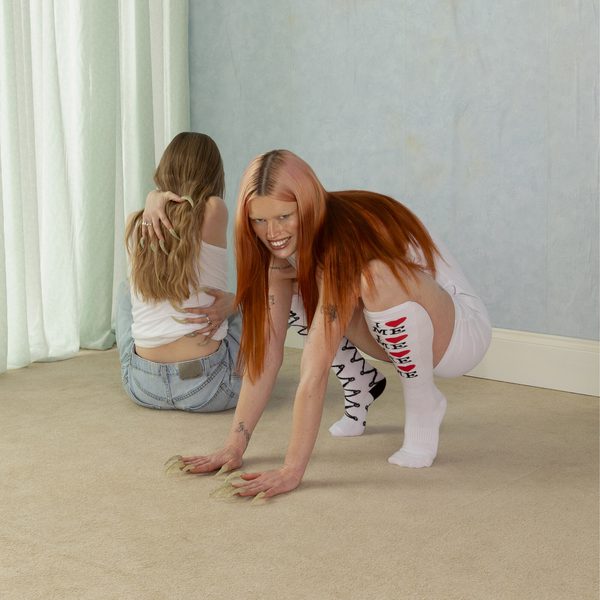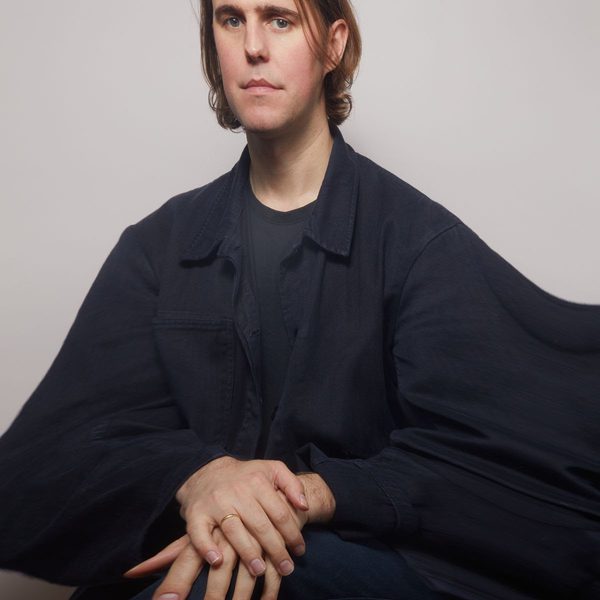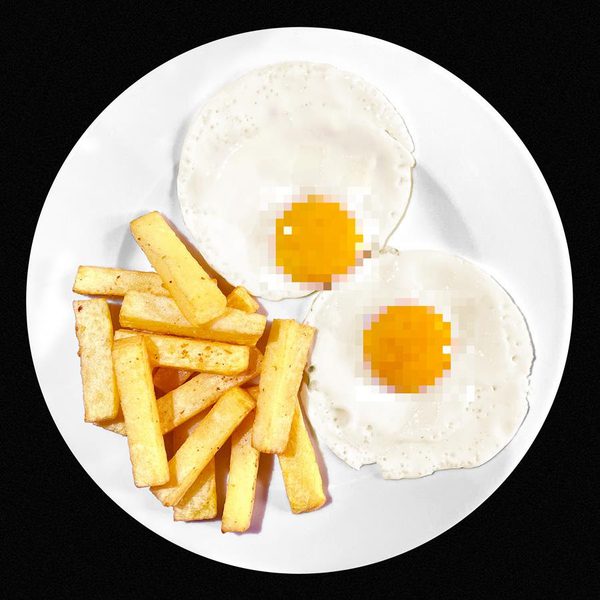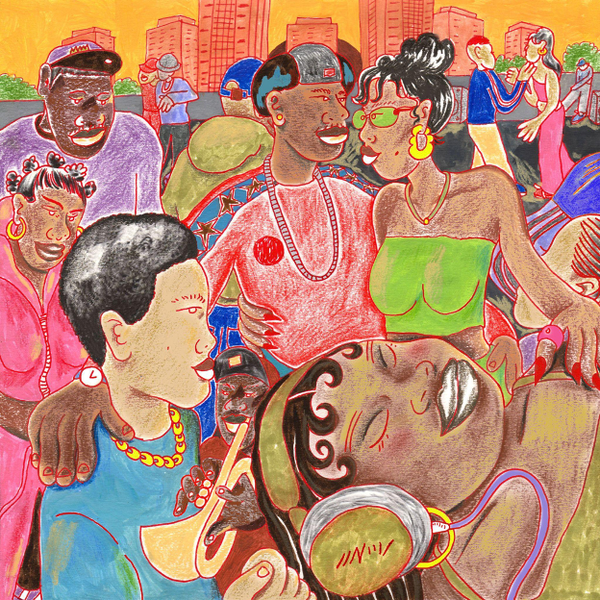
Defining the self
Ozark and The OA Composer Saunder Jurriaans shares the journey of mental health and meditation that inspired his debut solo record Beasts.
I speak to Saunder Jurriaans on Zoom the same day he received an Emmy nomination for his work on Ozark’s eerie and brooding score with fellow composer Danny Bensi.
I speak to Saunder Jurriaans on Zoom the same day he received an Emmy nomination for his work on Ozark’s eerie and brooding score with fellow composer Danny Bensi.
He is posted up in his studio, long hair hanging past the shoulders of his light purple T-shirt, and musing over the possibility of getting takeout sushi that evening to celebrate the nomination - after all, the options are limited in the age of COVID-19. Jurriaans and Bensi gravitate toward darker sounds in their score work, with the exception of a few Chef’s Table episodes and some lighter documentaries. “It’s just what interests us,” admits Jurriaans. “I don’t know why that is. I think Danny and I just love that kind of music. Moody, dark stuff, that’s where we go.” The Seattle native says that he could never write a whole symphony in a major key like Mozart, and that doing so would drive him totally nuts.
Written over the course of seven years and with many stops and starts, Jurriaans debut solo record Beasts is a cinematic examination of darkness and light, and grapples with the idea of dark and light within the self. It borrows sonic textures from the films and shows that Jurriaans has worked on through the years. “The Three Of Me,” the second to last song on the record, was written while Jurriaans and Bensi were scoring the film Magic, Magic. “It kind of crossed over because [with] Magic, Magic, we ended up scoring a lot of the film with these meditation bowls,” Jurriaans recalls. “We were using these meditation bowls and running them through tape players so they were kind of warbled and off and then layering them and tuning them in different ways. I ended up bringing that into [‘The Three Of Me’]. It became a really big part of that piece and actually the whole sound of it has a similar feeling to that film because we were running things through this cassette player for that film and I ran it through the cassette player for that song as well.”

“Easy Now” was written during the five-month period that Jurriaans and his wife (Argentina-born artist Patricia Iglesias) lived in Buenos Aires. “That whole time in my life was also a really tough time on my relationship,” Jurriaans tells me. “‘Easy Now’ was really about that, but with a little more of a sense of hope to it than some of the other songs. It was just during a tough time for both of us. We were both going through a lot. Since then. I feel like the song has kind of encompassed more about life in general… It feels like a healing song for some reason to me and I think even what we’re going through now as a society there’s something that the song reflects. I really like to look at songs that way, of how they applied to me when I wrote them and how they apply to my life now and let the words mean something else.”
Iglesias is responsible for the colorful doodled beasts that live on the album cover. Her drawings came at a moment when Jurriaans was struggling to find a name for his album, and the beasts were a perfect fit. Ironically, Iglesias does not gravitate toward gloomy music, as it sends her over the edge instead of helping her find catharsis. Despite their differences in musical taste, the two have been together for 18 years.
Different sonic drones and textures from past films have found themselves nestled into several of Jurriaans’ songs. “In the last song called ‘Miles to Go’ there’s a lot of this guitar feedback, it’s like when you put a guitar up to the amplifier speaker it does a kind of wailing sound. For Enemy, the film we did back in 2013, we recorded like 20 to 30 minutes of guitar feedback and I used some of that in [‘Miles to Go’] as well,” he explains.
“Miles to Go” is also Jurriaans’ favorite, as it started out as somewhat of a country song. The cowboy lament started out with just an acoustic guitar and vocals, but Jurriaans is far too much of a maximalist to leave it there. The track quickly morphed into a distorted symphony with an intentional mess of guitar feedback behind it. The finished product? A perfectly dystopian soundscape over a folk-song skeleton.
In Jurriaans studio, an eclectic selection of unusual instruments from all over the world hang from the walls, each one a result of a new film setting or desired aura. He uses so many instruments in his work on the album that listing the instruments for the label copy was nothing short of a nightmare. He has played the guitar since he was ten years old, and has also dedicated a couple of years to piano lessons (having a melody on one hand and chords on the other is an invaluable songwriting tool). As a film composer, he has learned to fake his way through just about every instrument you could imagine. “I love to just pick up random instruments and figure them out enough to record with, like flutes and clarinets and stuff,” he laughs. “I just laugh because I’m so bad at them, but I can fake it really well. With recording I can play a couple notes and then punch it in and then punch in another couple of notes… Don’t tell anyone that!”
He only recently moved to Los Angeles, after living in Brooklyn for over a decade. His studio was finished just in time for lockdown, all of his random acquired instruments and tools in their place and centered around a funky rug in the middle of the room. The space has become his quarantine lair.
With the help of Bensi, a cellist, Jurriaans is also able to navigate the world of string instruments with relative ease. Bensi played all of the strings on Beasts in numerous layers to create a full orchestral sound. Bensi plays several different string instruments on Beasts, but plays all of them, from cello to violin, like a cello, propped in his lap and sawing the bow from side to side.
The most difficult instrument for Jurriaans to grow comfortable with was his own voice. His bands with Bensi, Tarantula A.D. and Priestbird were instrumental until the last couple of albums. “I’m always a little self-conscious about it but that's another thing that over the years I've really come to accept and learn my range and strengths as a vocalist,” he reflects. “Actually, we do a lot of vocals now on our film scores. They’re not so many lyrics obviously, but a lot of weird kinds of textures and still that I’ll do with vocal harmonies, like create choir-like things.” One example of this vocal strategy can be heard on the soundtrack to The Outsider, which features one of Jurriaans’ songs “Lost Star” in the last episode. It was a perfect marriage between Jurriaans’ scoring and songwriting.
"I love the process of creating these worlds. It’s not really about the song that comes out for me, it’s about the making of it and the layering of stuff."
The sonic puzzle pieces that Jurriaans borrowed from his film scores came together in sporadic periods between jobs and at night. Some tracks were initially laid out and then revisited and revamped a year later. Layers would be added or taken away or the entire track would be stripped bare. The creation of Beasts was very much a chipping away process, but the result is transportive and packed with so many sonic textures that it sounds otherworldly, like waking up inside a film. When Jurriaans played in bands, the writing process was much more streamlined. With the making of Beasts, there were no rules. “I got to write songs in a weird inside-out way or maybe write the middle of a song and stretch it on either side, I don’t know,” laughs Jurriaans. “It’s always nontraditional.”
“I felt really insecure about the way I was working on stuff,” he admits. “I was kind of like ‘well this isn’t how a songwriter writes songs. You sit down with a guitar and the song comes out and the lyrics are perfect and the song is perfect and then you go to the studio and record’ and that’s not really how it happens. Often you lay down a chord progression and the lyrics will come later and maybe the lyrics were like a stream of consciousness thing which actually didn’t really find their meaning until later or something so it was actually kind of a strange process. I think toward the end when I decided to actually try to put this record out, I accepted that fact and became at peace with it in a way and accepted that part of me and that’s how I work and that’s what I love to do. I love the process of creating these worlds. It’s not really about the song that comes out for me, it’s about the making of it and the layering of stuff. I just have so much fun doing it.”

Sonically, Beasts is at once both introspective and observational, creating a soundscape so vivid that it is transfixing. Lyrically, the record is a self-examination of our inner darkness. Jurriaans doesn’t simply condemn our demons, instead he encourages the listener to acknowledge and get to know them as a means of transcending their control. “The songs came out of a period of my life where I was dealing with a lot of depression and anxiety and I was really coping with it in some dark ways,” Jurriaans reveals. “The band was breaking up, the scoring was starting to get busier, and I was kind of confused about what I was doing with my life. I went from touring all the time to being in one place and I was just having a tough time coping with that change and the idea that maybe that life was not happening for me and this other life was happening for me.” In this strange transitional time, he was working four jobs at once to pay the bills. He found himself coping with uncertainties by making destructive choices.
“I went into a really dark period and did a lot of dumb things… then I started to come out of that period and I was really fascinated as I was coming out of it, through a lot of help and in different forms, but I was really fascinated in looking back at who I was, trying to understand the idea of self and how I could be that person that I was and also be this person that is changing so much. It’s almost like looking at myself in multiple personalities,” says Jurriaans. “I would remember things about myself and I was like ‘that wasn’t me. How could I do that kind of thing?’ compared to where I am now. I’m just fascinated with that idea and all these ideas of darkness that lie dormant or come out and what ways it comes out and how we accept it and how we fight it and make it worse. It became this kind of obsession of mine and still is: The idea of how we build our story and how we build ourselves and then how we portray ourselves to the world.”
Jurriaans' exploration of the self was also guided by his mediation practice, which spans over a decade. Since he began work on Beasts, he has practiced a Tibetan-style meditation every morning, and then again during the day if time allows. Meditation does not just cover one’s sense of self, but also is expressed in what we create and beyond. The songs on Beasts all fall in a different stage of thinking as Jurriaans slowly realizes that dark places live inside all of us, but do not define our present and future. “I still have those demons and those dark parts of me,” he says. “I’m not lost in them anymore and I understand them now I think. I can look at them for what they are.”
"I kind of fell into this... and I love it but I need to be able to make music without somebody giving me notes. I need to be able to express fully my emotions and what I want to do musically.”
“I think that first of all, these songs came out of [that darkness] and I don’t think they would’ve come out without it,” he continues. “It’s something I’ve been thinking about a lot recently because I have certain things resurface every once in a while from those times that I have to deal with. Sometimes I feel a sense of shame or embarrassment and I have to remind myself that yeah, all the things I went through have added in some way to where I am now. I feel very good where I am now. I feel satisfied and my life is very full and it’s hard because if I look back I think ‘oh I was so stupid, imagine what I could do if I hadn’t done some of that stuff or hadn’t gone through that’ but it doesn’t work that way and all that stuff is what has created where I am. It’s a hard thing to think about, but I have to reframe the way I think about it I guess. And if it does resurface, I have to immediately try to acknowledge it instead of pushing it back or making it something subconscious where it will fester. Accept it and move on and be okay with it and use it to my advantage, whether it’s something to write a song [about] or put into a score, all those feelings work.”
A solo project was a breath of fresh air for Jurriaans, who has to abide by directors’ notes in his film scoring work. Film scoring work always starts with the composer, what they're feeling in reaction to the film, but it has to be a collaboration with the director. At times, those filters can be frustrating and push the music in a different direction than the composer wanted.
“[Bensi and I] never really set out to be film composers. We were performing musicians and we played in a band and that’s what we loved to do. I always wanted to play and when I was a kid, I was super into heavy metal and stuff. I wanted to be a rockstar,” he chuckles. “I kind of fell into this, which is great and I’m super happy that I did and I love it but I need to be able to make music without somebody giving me notes. I need to be able to express fully my emotions and what I want to do musically.”

In doing score work, Jurriaans and Bensi had to learn not to treat things as too precious. Sounds they love will inevitably be thrown at the window, right back onto their purgatorial hard drives until another chance at life arrives for it. Even if the piece is not gone for good, it can be frustrating to relegate something that you are passionate about to the back burner, waiting until another suitable film or project comes along. To be a film composer, you must learn to shed your ego completely, or it will crush you. It is not something every musician can do.
In the absence of critical director’s notes on the making of Beasts, Jurriaans found himself highly critical of his own work. “One of the reasons why it was so hard for me to release this music was that for so long I’d go through these waves of self-confidence, of confidence in the music particularly. I would go through years or a year of just not being able to listen to any of it and being totally afraid of it because of what it brought up for me, but also the idea of what to do with that,” he explains. “They’re there. They’re on my hard drive. Do I want people to hear them? There’s so many feelings tied up into those songs that it was so hard to take it to the next step where I could be like ‘let’s look and see if anybody cares.’ For a while it was this back and forth where I would ignore them for a long time and push them away and then suddenly I’d listen to them all and be like ‘this is great, these songs are great! I should put them out!’ and then in the end I finally got to this point where I was like ‘God I really don’t care what people think about them. I love them for what they are and I loved making them and I need to put them out.’”
When looking for new musical textures and inspiration, Jurriaans admits that he doesn't listen to very much music anymore. “Since I started scoring films and since I’m so immersed in writing music constantly, it’s hard to listen to music for fun,” he explains. He was largely inspired by the music he grew up with, from Led Zeppelin and Pink Floyd to Megadeth and Iron Maiden. You may not hear the overlap at first listen, but the harmonies and subtle complexities come from these artists who inspired him at age 10 to become a rockstar. “I was listening to David Bowie’s Hunky Dory the other day and I was realizing how much that inspired the recording process. Especially for me the way he used texture is something that’s really fascinating. For me, building a song might be more like a painting in terms of how to compose it so that it’s balanced or unbalanced in the right way. I feel that a lot with David Bowie’s stuff. The textures and sounds, like a crystalline acoustic guitar with a really deep punchy bass or something.”
His favorite records are more than a collection of pop songs. They are symphonies, worlds, sonic images composed of the smallest and most complex layers and brush strokes of an entire spectrum of color, every placement and choice made with an intention, even if at first glance we only see the big picture. Beasts is a call to look at the small things with a magnifying glass, to look at one’s own highs and lows, and acknowledge each of their contributions to the beautiful and ever continuing project that is one’s own life.
Get the Best Fit take on the week in music direct to your inbox every Friday

Wet Leg
moisturizer

MF Tomlinson
Die To Wake Up From A Dream

BIG SPECIAL
National Average





